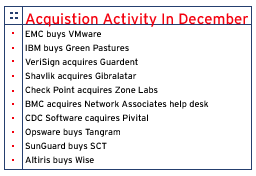Holiday Shopping: M&A Surge In Software Arena
EMC's blockbuster $635 million buyout last Monday of VMware, followed by IBM's purchase of Green Pasture and Red Hat's acquisition of Sistina Software capped a months-long flurry of M&A activity. And there's more to come, solution providers and observers say.
The software consolidation that has touched virtually every segment of the channel,from business intelligence to security to storage to content management,is a sign that vendors are starting to believe in a recovery and are scrambling to make deals before valuations rise. Increasingly, the industry sees bleak prospects for point solutions, and vendors are girding themselves to offer a bigger part of the total solution rather than furnishing pieces of a whole.

"There are still some good deals to be had, and the hardware and software companies that are buying are being forced by customers to be more solutions-focused so they need to fill the gaps," said Neal Prescott, a Boston-area IT consultant.
Solution providers said the consolidation makes it more critical than ever to choose vendor partners with financial muscle and channel commitment.
So, who's the next target? Smaller software companies with critical pieces that could fill the gaps for larger vendors racing to deliver on information life-cycle management and utility computing promises.
Among likely targets in 2004 are companies such as FileNet, Lawson, E.piphany, Vignette, Interwoven, Mercury Interactive and Art Technology Group. Likely buyers,most of whom have already dusted off their checkbooks,include IBM, EMC, Oracle, Sun Microsystems, SAP, Veritas Software and Microsoft.
"Consolidation is likely to accelerate because stock valuations are going up, there's new confidence about the business cycle %85 and even though prices [of targets] are rising, your own multiples are up, and you're more confident and thus more likely to buy," said one financial analyst who requested anonymity. "Also, you're starting to see an uptick in demand and want to grow your own offerings to take advantage of that."
Total solutions is more than the latest buzzword. Nobody can build an IT system on storage or operating systems alone.
With that in mind, channel observers say EMC has to break out of its storage ghetto, Microsoft needs to lose its desktop-only image, and IBM has to add vertical software to its portfolio.
And they're all trying to do just that. The companies that can execute acquisitions and integration well will win bigger footprints in existing enterprise accounts and capture new business, observers say.
That's why in October IBM bought up CrossAccess to ease access to non-IBM data. Hewlett-Packard snapped up Persist the following month for its storage archiving expertise.
Janet Perna, general manager of IBM Software's Data Management group, has had a front row seat to all this. Referencing Gartner data, she maintains the industry has seen a buying spree of the last few months that is now accelerating.
"We're now in the tornado phase of crossing the chasm," she said.

\
IBM's Janet Perna says the industry is in the 'tornado phase' of a buying spree.
In content management alone, there has been a huge amount of activity in the past six months, with Interwoven buying MediaBin and iManage, and OpenText buying Gauss and IXOS. Analysts attribute much of this activity to new regulatory requirements mandating companies closely track and store documents.
Those requirements have given rise to yet another acronym: ILM, for information life-cycle management, which is the grail most of these companies are chasing. For example, EMC plans to integrate its storage management with VMware's cross-server virtualization technology to help clients "freeze and store" dynamic application data.
One integrator said customers want ILM solutions to reduce the cost and complexity of data center management.
"We need process automation for our technology processes, and everyone from Oracle to Microsoft to HP, Cisco and EMC are targeting this," said John Parkinson, chief technologist for Cap Gemini Ernst & Young's North American Region.
A truly integrated ILM solution, however, isn't always good news for the channel.
"You want to do integration because consulting is a high-margin business and good VARs are making money from consulting," said David Crosbie, CEO of Leostream, an ISV and VAR specializing in virtual management software. "The trouble is, everyone including the vendors, wants a slice of that consulting pie, and they want to lock the user into their architecture."